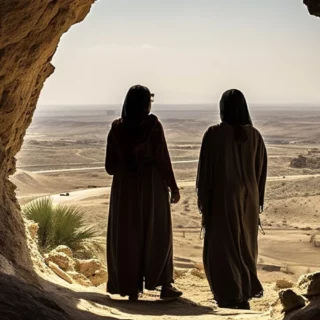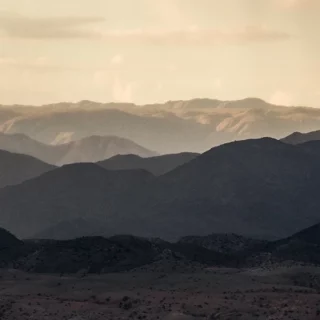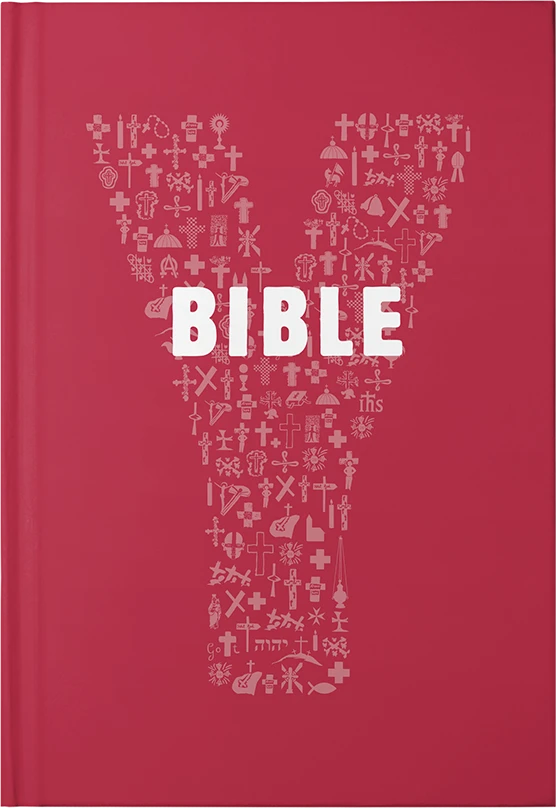

Credopedia
Prayer in the Bible
They are a collection of songs and prayers, some of them several thousand years old, which are still prayed today in the community of the church – in the so-called Liturgy of the Hours.
What is it?
The Holy Scriptures are not a single book, but a whole library. It contains the most diverse texts, mythical narratives, factual reports, hymns, law texts, love songs; even small novels can be found in it. A network of texts narrates the history of Israel and the beginnings of the church. Woven into this network like precious sparkling pearls, are prayers. Again and again, people have raised their arms to connect with heaven and earth. For Christians as well as Jews, everything begins and ends with prayer: “As long as Moses held up his hand, Israel was stronger; but as often as he lowered his hand, Amalek was stronger. Aaron and Hur supported his arms, one on the right and the other on the left, so that his hands remained raised until the sun went down.” (Ex 17,11) Someone once counted and discovered a total of 215 prayers in the Scriptures. And not infrequently, such prayers are found at the turning points and high points of the relationship with God. “Pray without ceasing,” Paul recommends in 1 Thess 5,17.
What does the Holy Bible say?
The history of Israel is a story of the discovery of the one true God. The first person in the Bible to enter into living exchange with this God, that is, to pray, was Abraham (Gen 20,17) “Abraham,” says YOUCAT 471, “listened to God. He was willing to go where God wanted and to do what God wanted … When Abraham saw that God wanted to destroy the sinful city of Sodom, he interceded on its behalf. He even wrestled persistently with God. His intercession for Sodom is the first great supplication in the history of God’s people.” From Abraham on, Israel prays. Central prayer warriors in the Old Testament are Moses (“The Lord and Moses talked eye to eye, as men talk to one another.” Ex 33,11) and David, whom the Bible names as the author of 150 psalms. “The Psalms,” says YOUCAT 473 “belong, along with the Lord’s Prayer, to the greatest treasure of prayer in the Church. In them, the praise of God is sung in an everlasting way. They are a collection of songs and prayers, some of them several thousand years old, which are still prayed today in the community of the church – in the so-called Liturgy of the Hours. The Psalms are among the most beautiful texts in world literature and also touch modern people directly through their spiritual power.” Israel calls out to God “in the evening, in the morning, and at noon” (Ps 55,18) and from the Psalm verse “Seven times a day I sing your praise” (Ps 119,164) are developed the hourly prayer of the church and finds a distant echo in the five times prayer of the Muslims, the Salah, and the Tawāf, and the seven times around the Kaaba. In the New Testament, the prayer takes off with Mary’s hymn of praise, the Magnificat. “Jesus” is said in YOUCAT 474 “learned to pray in his family and in the synagogue. But Jesus went beyond the limits of traditional prayer. His prayer exhibits such a connection with the Father in heaven as only he who is ‘Son of God’ can have.” One of the most beautiful prayers of Christ is found in Eph 1,3-14, but the measure of all prayer in Scripture is Jesus prayer, which revolves around the one word “your will be done” (Lk 22,42).
A short YOUCAT-Catechesis
God Centered
St. Mother Teresa (1910-1997) has as many admirers as despisers. Those who do not like her and spread bad things about her consider her to be a somewhat narrow-minded Catholic who was only concerned with proselytizing and bringing people to heaven. But this is not true at all. She has certainly accompanied more Hindus and Muslims in their last hour than Christians, has respected their religious beliefs and customs, has also financed funerals according to their rite. “Race and religion,” she once opined, “don’t matter, we are all children of God, created to love and be loved.” Yes, she was even fascinated by some religious expressions and tried to learn from them. For example, how to pray. Once she said to her sisters, “The Hindus give this tikka on the forehead (meaning the red dot) – they use it for beauty, but it has a tremendous meaning: God centered.”
The dot on the forhead
I like this word “God centered”. It sums up worlds – the world of Scripture and my life. We all wonder: where is the journey going? What will happen to me, to my children? What about our society? What about this groaning, plundered planet Earth? What’s next for us? What should we focus on? “Focus on your dream,” says the lifestyle coach. Buddha says, “Focus on the present moment.” The business consultant recommends, “Focus on your core competency.” The Dalai Lama says, “Focus on inner beauty.” Only the Scriptures point away from eternal circling around myself; there we hear, “Hear, Israel! The LORD our God, the LORD is only. Therefore you shall love the LORD your God with all your heart, with all your soul, and with all your strength. And these words, to which I commit you today, shall be written on your heart. … They shall become an ornament on your forehead.” (Dt 6, 4.8)
There it is again – the tikka, the red dot, the mark on the forehead. God centered. He is the one who centers us – that is, directs us together towards the good. He shows where the journey is going. That is the central message. And that is why Christianity without prayer – that is, without living contact with God – is simply unthinkable, or it is as undrinkable as a stale broth.
Get an alignment with God
In the Old Testament we already see how order becomes a world, of which one can have the impression that it removes itself daily further from its paradisiacal origin. More and more new waves of violence and destruction break over mankind, although there are heroic people who stand up against evil. The history would be endless drama of the wickedness, a disaster history in increasing continuations, God would not interrupt us. Salvation and order come into the world by God intervening in the normal course of things.
The God of the Old Testament is a God who comes forward and starts a conversation with us. Unexpectedly, on the next street corner, at the office, or while tending sheep. That’s how it was with Moses. It was not Moses who had the idea to pray. God centered him in a fiery way in the nowhere of the steppe, at a half-dried thorn bush. YOUCAT 472 says: “From Moses we can learn that to pray is to ‘talk with God.’ At the burning bush, God entered into a real conversation with Moses and gave him a commission. Moses raised objections and asked questions. Finally, God revealed His holy name to him. Just as Moses trusted God at that time and allowed himself to be completely commissioned, so we too should pray and thus enter the school of God.”
This is the model that has not changed until today. God knocks on every life story. Often we do not hear this knocking. But when we open the door, HE is there – talking to us. YOUCAT 470: “One feels lonely, has no one to talk to, and then feels that God is always there to talk. One is in danger and learns that the call for help is answered by God. Praying is as human as breathing, eating, loving. Praying purifies. Praying enables resistance to temptation. Praying strengthens in weakness. Praying takes away fear, doubles strength, gives longer breath. Praying makes happy.” Praying orients in a disoriented world. Christians wear an invisible dot on their foreheads. One could also say: they carry a star in their chest, a mystery that guides them infallibly, that aligns them with God.
Pray with Jesus
If praying means being in touch with the ultimate source of everything, then only one was a master in prayer: Jesus. Jesus is the point towards which all lines in the Holy Scriptures run. All prayers, all praising, asking, thanking, lamenting – it runs towards Jesus. This recitation of the Psalms that has gone on for millennia, this endless shouting in millions of monasteries, churches and cathedrals – it is a speaking, shouting, rejoicing in, and with, and through, and toward Jesus, as if all the waters that flow toward God must pass through this one channel. There is no Christian praying past Jesus.
The great image of Jesus praying is the image of the Mount of Olives. Jesus is fully human and unites all human fear in himself. With his hands raised to heaven, he sweats blood (Lk 22,44). Jesus transfers the drama of all failure on earth into the trust that with God everything will be all right in the end, that is why he says just there where nothing works anymore: “… not my will, but yours, be done.” (Lk 22,42) The whole Gospel of John revolves around this single, decisive relationship, which is repeatedly mentioned and expressed: the relationship of the Son to the Father. This relationship leads into the groundless depths of God, into love itself – and it is powerful, powerful enough to change the world: “The Father loves the Son and has given all things into his hand.” (Jn 3,35)
Christians actually believe that “everything” – and that really means everything – has been given into the hand of Jesus, down to the smallest concerns of our everyday life, and of our family. So, when we focus on Jesus, when we are in prayerful relationship with him, we are actually on the heart of things: with our dear Father. YOUCAT 477 says: “To learn to pray from Jesus is to enter into his boundless trust, to tune into his praying, and to be led by him step by step to the Father.” The Father is, in a sense, the tikka on Jesus’ forehead. And the shortest and most powerful prayer in the world – the sign of the cross – is the tikka of Christians: “In the name of the Father, the Son and the Holy Spirit.”
Bring your heart there!
One of the great teachers of the faith, Francis de Sales, once said, “When your heart wanders or suffers, gently return it to its place and gently transfer it into the presence of your Lord. And even if you have done nothing in your whole life except to bring your heart back and place it again in the presence of our God, though it wandered away every time, then you have fulfilled your life.”

YOUCAT Digital
Discover our digital products, which will help you to grow in faith and become missionaries yourself.







